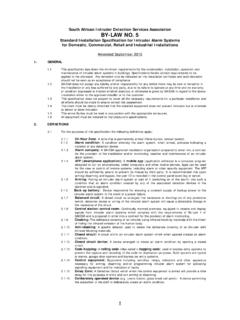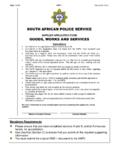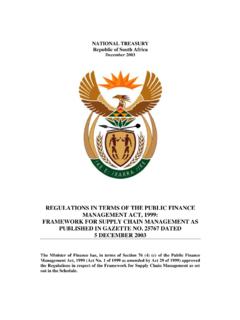Transcription of SOUTH AFRICAN INTRUDER DETECTION SERVICES …
1 BY-LAW NO. 6 SOUTH AFRICAN INTRUDER DETECTION SERVICES ASSOCIATIONR equirements for a SAIDSA Approved Central Station for CCTV off-site Monitoring which includes 24 Hour Active Monitoring and/or Alarm Verification MonitoringAmended October 2015 PREAMBLEThe construction of the Central station is intended to prevent or delay unauthorised entry and to en-able the occupants to raise an alarm in the event of an attack. These are categorised as follows, the requirements of each being dealt with under separate headings:-1. Construction 2. Permitted Openings 3. Normal Entrance 4. Doors 5. Emergency Exits 6. Glazed Areas 7.
2 Ventilation Inlets and Outlets 8. Alarm Protection to the Central Station 9. Closed Circuit Television 10. Personnel Entry to Central Station 11. Telephone Lines 12. Power Supply 13. Central Station Antenna 14. Relay Sites and Repeater Stations 15. Signals received from a CCTV installation 16. Records 17. Supervisory Checks 18. Procedure Manual 19. Maintenance 20. Stand-by Equipment 21. Data Protection and Storage1. CONSTRUCTION All parts of the fabric of the Central Station shall be of substantial construction. Substantial construction is taken to Walls: At least 230mm of cement mortar brick work or 150mm reinforce Roof/Ceiling: Suitably reinforced concrete at least 120mm thick, or steel to the equivalent PERMITTED Permitted openings only are allowed as specified Normal entrance Emergency Glazed Ventilation inlets and Service inlets and outlets3.
3 NORMAL A normal entrance shall comprise at least two interlocked doors separated by a Both doors cannot be opened The area between interlocked doors may not have other permitted The lobby shall be of the same construction as the central The doors together with their hinges, frames and locking devices shall be of substantial Where timber doors are used, both doors shall be at least 44mm thick, and of solid-core construction faced with a mild steel sheet of a minimum thickness of 1,5mm on both On an outward opening door, hinge bolts must be used. All other hinges shall be internal. The locks securing the doors shall be of a high security type.
4 All locks must be installed to manufacturers specifications and must resist a sudden EMERGENCY Emergency Exits shall comply with the requirements above, however, a single door is acceptable and no lobby is The Emergency Exit door shall be easily opened from the inside. This shall comply with local fire regulations. The Door must be alarmed on a 24 hour non-shuntable zone and must be monitored by a SAIDSA approved Central Where timber doors are used, both doors shall be at least 44mm thick, and of solid-core construction faced with a mild steel sheet of a minimum thickness of 1,5mm on both The doors must be tamper proof from the GLAZED Any glazed areas shall offer resistance to forced entry at least equivalent to that of three-ply laminated glass of 15mm thick, in sheets not larger in area than 1,5 square metres.
5 Where glazed areas are larger than square metres, they shall offer resistance to forced entry at least equivalent to that of European Standard EN1063 BR3-S for internal glazed areas, and BR4-S for external glazed areas. The member must be able to provide a certificate from a supplier confirming the standard of the glazed area installed. Frames and fixings must be of substantial construction. No opening sections are permitted in the glazed Where windows are line-of-sight, suitable Flatex or a minimum of 20mm diamond mesh of metal construction must be VENTILATION INLETS AND OUTLETS The cross sectional area of the inlets and outlets shall not exceed 0,02 square metres.
6 It shall be ensured that the interior/staff of the Central Station are not within direct line of sight from the outside. Ventilation piping/ducting must be protected by means of suitably constructed right angle Ventilation inlets and outlets shall be suitably protected against physical attack. The inlets must be situated within a protected area or alternatively, be Suitable air-conditioning is to be provided in the Central Adequate ventilation to be supplied to cycle and replace the air within the Central Station every 30 ALARM PROTECTION TO THE CENTRAL Deliberately activated devices (emergency switches) shall be strategically sited within the Central Signalling from the above deliberately activated devices will be directly to the Central Station of another SAIDSA approved Central Station.
7 Such signalling must be tested weekly. 9. CLOSED CIRCUIT All permitted openings to the Central Station shall be suitably monitored by vandal resistant closed circuit television Recording of the cameras as per above shall be provided at at a minimum of 6 frames per second per camera with a history of at least 24 hours with time/date ENTRY TO CENTRAL Where 4 or more operators are utilised in the Central Station, access control should be provided which includes a time event Entry to the Central Station other than by authorised personnel shall require positive identification by the Central Station operators.
8 11. TELEPHONE Where Telkom or other service provider regulations and techniques permit there should be a minimum of two exchange telephone lines for voice These telephone lines shall be routed separately from the building, underground or One telephone line shall be barred from incoming Cellular communications are acceptable, but must be a In all communications with the police and response companies, a reference number shall be obtained and All records to be kept for a minimum of twelve (12) POWER The electricity supply may be either from external mains or from a battery standby. In the event of a disruption of the external electricity supply, the stand-by power supply shall automatically be brought into use without The stand-by supply shall include batteries located within the Central Station, capable of sustaining the monitoring equipment for a period of not less that 24 hours or not less than 50 minutes if a standby generator is installed.
9 The standby generator shall have an independent means of starting without leaving the control room The amp hour capacity of the standby power supply shall be calculated on the basis of the average hourly current drain multiplied by the factor Any recharging facility of the standby power supply shall be sufficient to provide the maximum load requirements and to simultaneously recharge the battery from that discharged state to the required capacity within 24 hours. In the event of an interruption in the mains power supply, all equipment essential to the operation of the Central Station shall continue to operate without loss of security or degradation of CENTRAL STATION ANTENNA (including any antenna receiving/transmitting RF signals) The antenna must be sited within close proximity to the Central Station.
10 Where this is impracticable, then the aerial and any connecting cables should be suitably protected against any mechanical damage or unauthorised The antenna shall be protected by suitable electronic INTRUDER DETECTION devices to detect RELAY SITES AND REPEATER Where the service provider permits, a comprehensive signal test shall be carried out every hour to ensure the efficient working order of all relay sites, repeater stations and receivers and all records of such tests shall be SIGNALS RECEIVED FROM A CCTV Receipt of a signal from a CCTV installation shall give a visible and/or audible RECORDS The following records should be kept in the Central Record of visual events received giving details of action taken and Customer database backups may not be older than 24 Electronic on-line back up equipment must be optically and electronically isolated.












